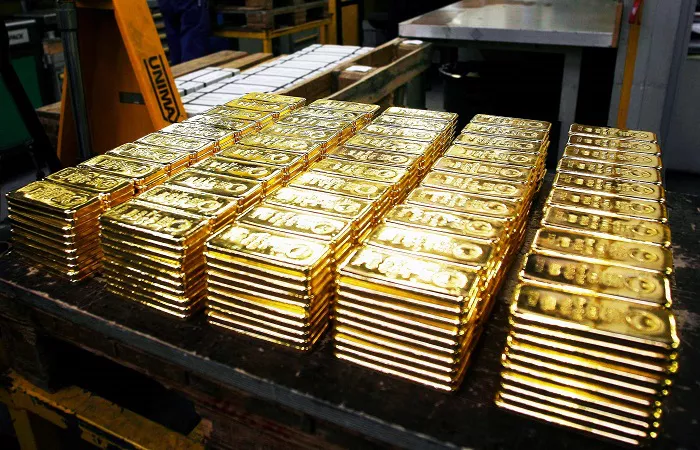Gold prices have reached new all-time highs this week as investors flock to the precious metal amid rising geopolitical tensions and economic uncertainty driven by President Trump’s controversial tariff policies. Early Tuesday, gold futures hit a record price of $3,177 per ounce before easing slightly. Despite this dip, gold has risen more than 18% since the beginning of 2025, while the S&P 500 has fallen over 4% during the same period.
Tariffs Fuel the Gold Surge
The recent surge in gold prices is largely attributed to President Trump’s ongoing tariff policies, which are creating widespread uncertainty in both global markets and U.S. businesses. Fears that tariffs will increase consumer prices and potentially trigger a U.S. recession have sparked panic among investors. This climate of uncertainty, exacerbated by tensions with major trading partners, has driven demand for gold, traditionally seen as a safe haven during times of economic instability.
On Wednesday, President Trump is expected to announce additional tariffs, a move he has dubbed “Liberation Day.” While these tariffs are still unfolding, the unpredictability of Trump’s announcements—coupled with the economic fallout—has already shaken markets and fueled demand for gold as a hedge against further uncertainty.
Analysts Predict Further Price Gains
The price of gold has been climbing steadily for years, but the sharp uptick in 2025 is largely due to concerns over tariffs. Michael Widmer, head of metals research at Bank of America, forecasts that gold could reach $3,500 per ounce over the next 18 months. According to Widmer, the recent surge has been “almost exclusively driven” by fears surrounding tariffs and their potential economic consequences. He points out that the ongoing uncertainty regarding U.S. economic policies has been a major driver of gold’s rally.
Gold’s Role as a Safe-Haven Asset
Gold is often referred to as a “safe haven” investment, particularly during times of economic or political instability. Lee Baker, a certified financial planner and CEO of Claris Financial Advisors, explains that when market conditions deteriorate, investors often turn to gold for its tangible, intrinsic value. “When it seems like the world is going to hell in a handbasket, gold usually appreciates,” he says. However, despite its reputation for stability, Baker cautions that gold can be volatile, and its value may fluctuate based on broader market conditions.
Considerations for Gold Investors
While gold can offer safety during times of crisis, it’s not without its drawbacks. Unlike stocks or bonds, gold doesn’t generate dividends or interest. The only way to profit from gold is by buying it at a lower price and selling it at a higher one, which makes it speculative in nature. Additionally, for those buying physical gold, storage, security, and insurance become major concerns.
For investors who are hesitant to deal with the physical aspects of gold, Baker suggests considering gold-backed exchange-traded funds (ETFs), which offer exposure to gold without the logistical challenges of ownership. However, he warns against buying gold purely based on its recent price surge. “If you’re buying gold right now just because you’re caught up in the buzz, because it’s going up—I’d probably say leave it alone,” he advises. “It’s likely to lead to some form of disappointment.”
Baker also underscores the importance of diversification in any investment strategy. “Your mama told you not to put all your eggs in one basket,” he says. “It applies to investing as well. Diversification matters.”
As gold prices continue to rise amid tariff-related uncertainties, investors should weigh the potential benefits against the risks of volatility and consider a diversified approach to their portfolios.
Related topics:
- India Surpasses China in Gold Purchases, Buying 51% More in Three Months
- Qilu Bank Enhances Support for Small Businesses with Innovative Financial Tools
- Bitcoin Poised for a Surge Amid Gold’s Delivery Delays, Expert Claims


